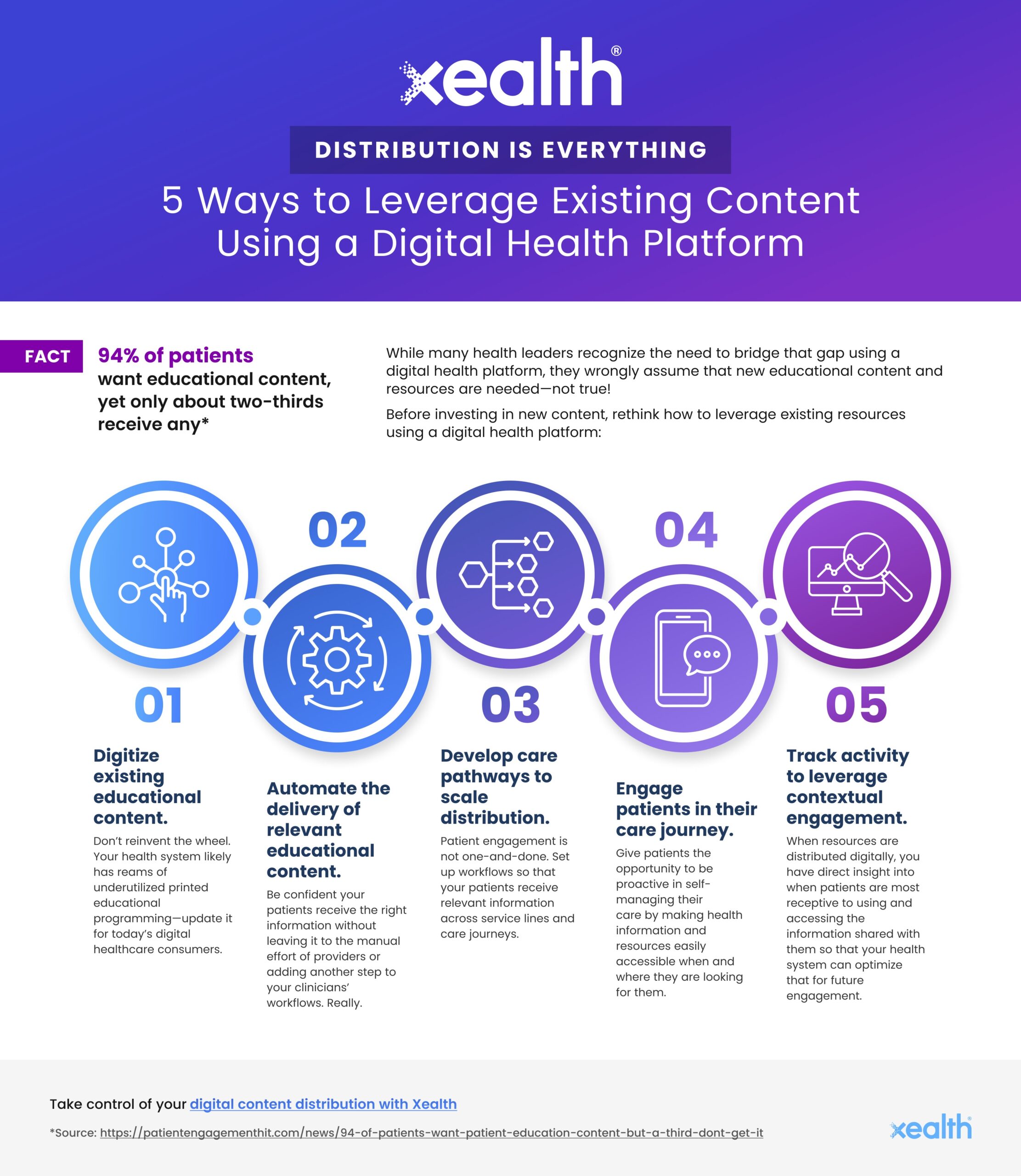Note to readers: This is the fourth post in a six-part series exploring the economics of digital health.
The relationship between patients and providers is indispensable in today’s fast-paced healthcare environment.
Integrating digital tools is no longer optional — it’s necessary for enhancing patient engagement and satisfaction. While patients still trust and value their relationships with doctors, health system staffing shortages mean providers must rely on technology and asynchronous touch points to provide care.
For example, Virtua Health leverages artificial intelligence to optimize marketing and messaging, ensuring patients receive relevant and timely information. The health system targeted people with or at risk of developing cardiovascular disease. Their messaging campaign increased patient engagement and scheduled check-ups and generated roughly $800,000 in revenue.
Platforms like Xealth play a significant role in this transformation, enabling healthcare providers to engage patients more effectively. Ignoring digital patient relationships can lead to substantial costs, including poor health outcomes and decreased patient satisfaction.
Understanding Digital Relationships in Healthcare
Digital relationships in healthcare involve continuous, interactive communication between patients and providers using various digital tools. These relationships are vital for managing appointments, sharing information, and providing support.
For instance, by implementing effective digital communication strategies, Confluence Health achieved a remarkable 1% no-show rate for COVID-19 vaccination scheduling.
In chronic disease management, telemonitoring and wearables have proven invaluable, enhancing patient independence and security. High-quality digital interactions are crucial for improving patient outcomes and satisfaction, fostering a more engaged and proactive patient base. These communications need not be overly complicated. Rather, it’s important to focus on leveraging the right existing asset or content in context with the care delivered to achieve ideal patient experiences and outcomes.
Key Metrics for Measuring Digital Relationship Quality
Let’s define the most relevant metrics categories and identify the best metrics within them for assessing the effectiveness and satisfaction of digital patient relationships:
Engagement metrics
Patient activation measures: Assessing an individual’s skills, confidence, and willingness to manage their health, leading to:
- Increased engagement and utilization
- Improved health outcomes
- Enhanced healthcare efficiency
Usage patterns: Tracking how patients use digital health resources, such as remote monitoring and educational content, helps achieve:
- Effectiveness of digital tools
- Personalized care delivery
- Improved quality of care
Adherence rates: Measuring how consistently patients follow prescribed digital therapeutic regimens, correlating with:
- Better health outcomes
- Tool effectiveness
- Resource optimization
- Predictive analytics
Satisfaction metrics
Net Promoter Score (NPS): This score determines patient loyalty and their likelihood to recommend digital health services, offering insights into the overall patient experience.
Patient satisfaction scores: Surveys and feedback forms gauge patient contentment with digital interactions.
For example, by automating the delivery of a Healthwise Shared Decision-Making tool through Xealth, UPMC achieved a 55% open rate, with nearly half of the patients completing the questionnaire, thus improving patient satisfaction.
KPIs for Patient Experience, Trust, and Attention
To measure the quality of digital patient relationships, it is essential to focus on key performance indicators (KPIs) for patient experience, trust, and attention:
Patient experience KPIs
Ease of use: Evaluating the user-friendliness of digital platforms through usability testing and patient feedback.
Timeliness of responses: Measuring the speed of responses to patient queries via digital channels to maintain trust and satisfaction.
Consistency across touchpoints: Ensuring a uniform experience across all digital interactions. A robust digital front door strategy is a critical component.
Trust metrics
Secure communication: Assess patient confidence in the security and privacy of digital communications.
Transparency measures: Provide clear information about how patient data is used and protected
Patient testimonials and reviews: Collect and analyze patient feedback on their trust in digital health services.
Allina Health, for example, struggled with patients claiming they had not received Annual Wellness Visit (AWV) educational information. By leaning on Xealth to systematically create digital touchpoints for Medicare patients reminding them about their eligibility for a covered AWV, Allina is making it easier for Medicare patients to receive care and potentially preventing long-term negative outcomes. By delivering related materials consistently and through multiple channels, the health system achieved promising engagement results, with nearly 20% open rates, 13% click rates, and 10% overall interaction from the Medicare population.
Attention metrics
Engagement duration: Measure how long patients spend interacting with digital health tools.
Frequency of interactions: Track patient engagement frequency.
Content completion rates: Assess whether patients complete educational or therapeutic modules.
UPMC’s use of automated emails to engage patients, for example, achieved tangible success:
- Over 50% patient engagement
- 25.2% viewed an educational video
- 10-15% clicked through to schedule mammogram and colonoscopy appointments, resulting in thousands more visits scheduled
Building and Maintaining Trust with Patients
Effective patient support in digital relationships involves personalization, regular communication, and responsive assistance.
Personalization: Tailor digital health interactions to individual patient needs and preferences.
Responsive support: Provide prompt assistance and address patient concerns quickly.
Regular communication: Keep patients informed and engaged through consistent and timely updates.
Nebraska Medicine faced challenges with patient education via Emmi due to limited EHR integration and cumbersome login requirements, resulting in low engagement. By integrating Emmi with Xealth, they achieved a 30% campaign open rate and a 10% interaction rate as new content became instantly available and easily accessible through the patient portal.
Achieving the Appropriate Level of Attention
Ensuring effective digital health interactions involves engaging patients at appropriate times, avoiding notification overload, and continuously improving through patient feedback.
Contextual engagement: Engage patients at appropriate times, such as during scheduled appointments or relevant health milestones.
Reducing digital fatigue: Avoid overloading patients with too many notifications or interactions.
Feedback loops: Continuously gather and act on patient feedback to improve digital health experiences.
Create High-Quality Digital Relationships with Data Analysis
Measuring and optimizing the quality of digital relationships in healthcare is paramount. Good digital relationships enhance patient engagement and adherence to treatment plans, improving health outcomes and increasing revenue for healthcare providers by reducing no-show rates and optimizing resource utilization.
Leveraging platforms like Xealth can significantly enhance patient engagement and satisfaction, leading to optimal digital relationships. To learn how Xealth’s centralized integration suite helps facilitate the highest-quality relationships possible, request a demo today.



